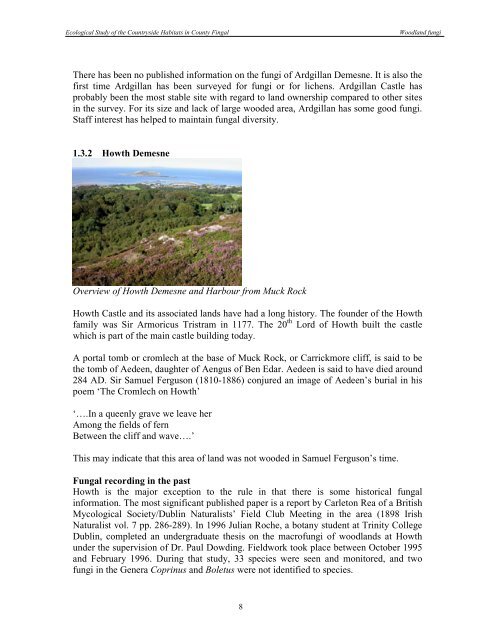2006 Fungi of Fingal Woodlands - Fingal Biodiversity
2006 Fungi of Fingal Woodlands - Fingal Biodiversity
2006 Fungi of Fingal Woodlands - Fingal Biodiversity
Create successful ePaper yourself
Turn your PDF publications into a flip-book with our unique Google optimized e-Paper software.
Ecological Study <strong>of</strong> the Countryside Habitats in County <strong>Fingal</strong> Woodland fungi<br />
There has been no published information on the fungi <strong>of</strong> Ardgillan Demesne. It is also the<br />
first time Ardgillan has been surveyed for fungi or for lichens. Ardgillan Castle has<br />
probably been the most stable site with regard to land ownership compared to other sites<br />
in the survey. For its size and lack <strong>of</strong> large wooded area, Ardgillan has some good fungi.<br />
Staff interest has helped to maintain fungal diversity.<br />
1.3.2 Howth Demesne<br />
Overview <strong>of</strong> Howth Demesne and Harbour from Muck Rock<br />
Howth Castle and its associated lands have had a long history. The founder <strong>of</strong> the Howth<br />
family was Sir Armoricus Tristram in 1177. The 20 th Lord <strong>of</strong> Howth built the castle<br />
which is part <strong>of</strong> the main castle building today.<br />
A portal tomb or cromlech at the base <strong>of</strong> Muck Rock, or Carrickmore cliff, is said to be<br />
the tomb <strong>of</strong> Aedeen, daughter <strong>of</strong> Aengus <strong>of</strong> Ben Edar. Aedeen is said to have died around<br />
284 AD. Sir Samuel Ferguson (1810-1886) conjured an image <strong>of</strong> Aedeen’s burial in his<br />
poem ‘The Cromlech on Howth’<br />
‘….In a queenly grave we leave her<br />
Among the fields <strong>of</strong> fern<br />
Between the cliff and wave….’<br />
This may indicate that this area <strong>of</strong> land was not wooded in Samuel Ferguson’s time.<br />
Fungal recording in the past<br />
Howth is the major exception to the rule in that there is some historical fungal<br />
information. The most significant published paper is a report by Carleton Rea <strong>of</strong> a British<br />
Mycological Society/Dublin Naturalists’ Field Club Meeting in the area (1898 Irish<br />
Naturalist vol. 7 pp. 286-289). In 1996 Julian Roche, a botany student at Trinity College<br />
Dublin, completed an undergraduate thesis on the macr<strong>of</strong>ungi <strong>of</strong> woodlands at Howth<br />
under the supervision <strong>of</strong> Dr. Paul Dowding. Fieldwork took place between October 1995<br />
and February 1996. During that study, 33 species were seen and monitored, and two<br />
fungi in the Genera Coprinus and Boletus were not identified to species.<br />
8


